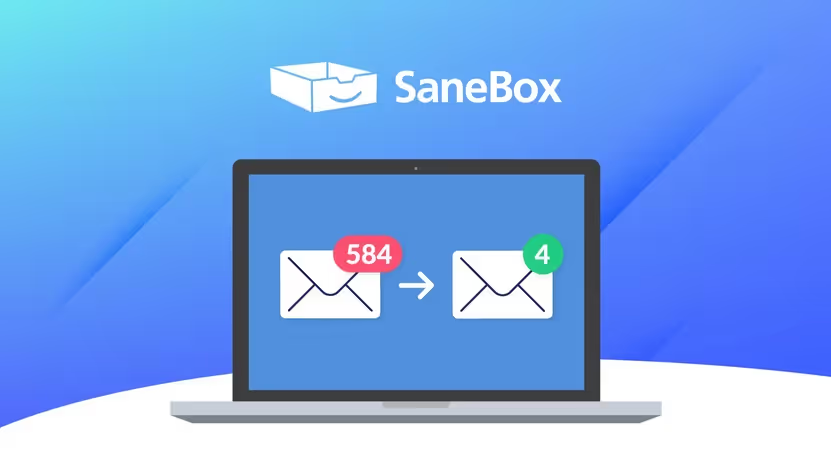SaneBox is an AI-driven email assistant that works behind the scenes to filter, sort, and triage your incoming mail. Launched around 2010 by Dmitri Leonov, it connects to any mailbox (Gmail, Outlook, iCloud, etc.) and uses machine learning to move low-priority messages out of your main inbox.
However, SaneBox is chiefly aimed at individual power users. It works with any email service (no app install needed) and is billed as per the number of features, but it lacks deep team or workflow integrations.
This review will dissect SaneBox’s core features and shortcomings, then compare it to five leading alternatives (Gmelius, Superhuman, Fyxer, Missive, and Hiver) to help you pick the best replacement.
What Is SaneBox? Unboxing the Platform
SaneBox launched in 2010 with the goal of decluttering overloaded inboxes. Its core technology is a smart filtering engine that learns what you do want to see and what you don’t, based on your email habits.
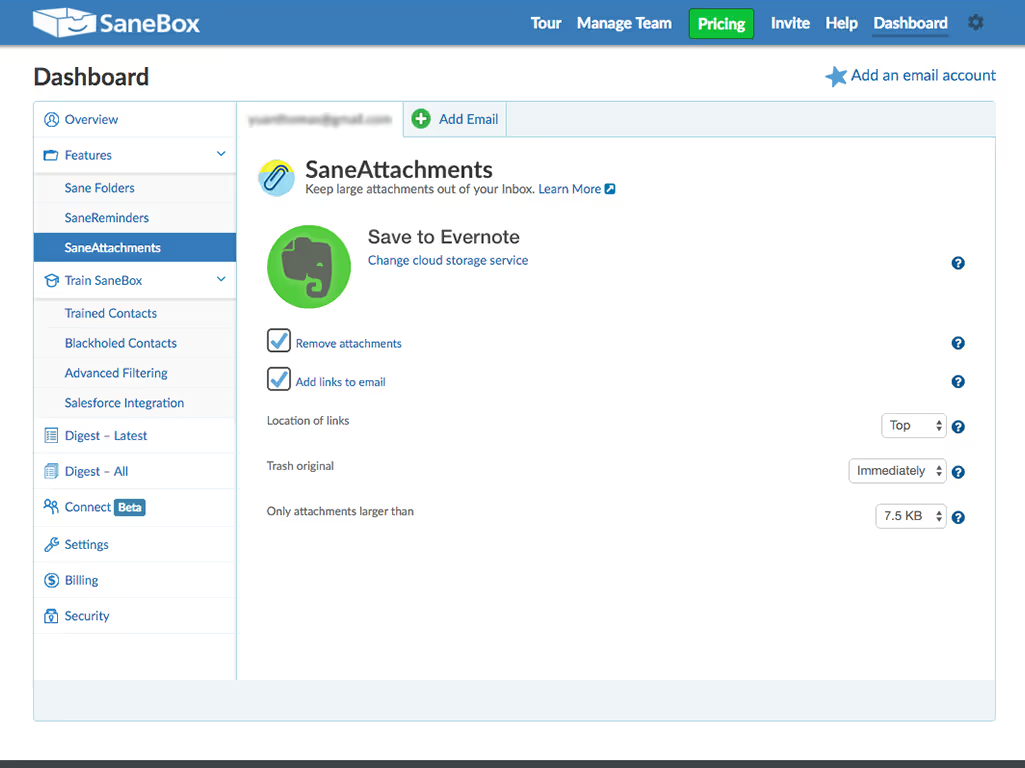
Every incoming message is scored by the SaneBox algorithm: important mail stays in Inbox, while the rest is quietly filed away. By default, newsletters and marketing emails go into “News” folders, social updates and less-important threads go into “SaneLater,” and so on.
All of these filtered messages are still accessible later – for example, SaneBox bundles them into a Daily Digest email you can review once a day. In short, SaneBox is “an AI-based email assistant that organizes any inbox (Gmail, Outlook, etc.) without a dedicated UI change”.
Behind the scenes, SaneBox uses machine learning to classify mail. It continuously adapts as you train it: if you move an email back to Inbox, SaneBox “learns” that this sender or topic is important.
It works with every major email provider (Gmail, Office 365, Yahoo, Fastmail, etc.) and any email client, and is therefore suitable for users who juggle multiple addresses or platforms. You can add up to four email addresses to a single SaneBox account.
SaneBox Key Features: What to Expect
Sanebox offers:
- Inbox cleaning and filtering: SaneBox automatically sorts incoming mail into priority vs. non-priority. Unimportant messages (ads, newsletters, low-reply threads) are moved into folders like SaneLater, SaneNews, or SaneBlackHole. This cleans up the main inbox view by deferring distractions.
- Email organization folders: In addition to SaneLater and SaneBlackHole, SaneBox offers specialized folders such as SaneCC (for messages where you are only CC’d) and custom folders you can define. You can train the system by dragging mail between folders; the algorithm learns from your actions to improve future sorting.
- Daily digest summaries: Instead of opening a chaotic inbox, you can opt to receive a Daily Digest – a single email summary of everything SaneBox filtered out. It lists senders and subjects, so you can quickly scan what you missed. This turns your “junk” folder into a daily newsletter of background items.
- Email filters and rules: SaneBox’s core is essentially an intelligent filter. It looks at sender, subject, your past behavior, etc., to automatically triage mail. For example, it will recognize persistent newsletters or automatic notifications and route them without manual rules.
- Snooze and reminders: Any email can be snoozed until a specified time (later that day, next week, etc.), temporarily hiding it from your inbox. You can also set reminders on outgoing emails: if a recipient hasn’t replied in X days, SaneBox will remind you to follow up. This ensures important conversations don’t slip through the cracks.
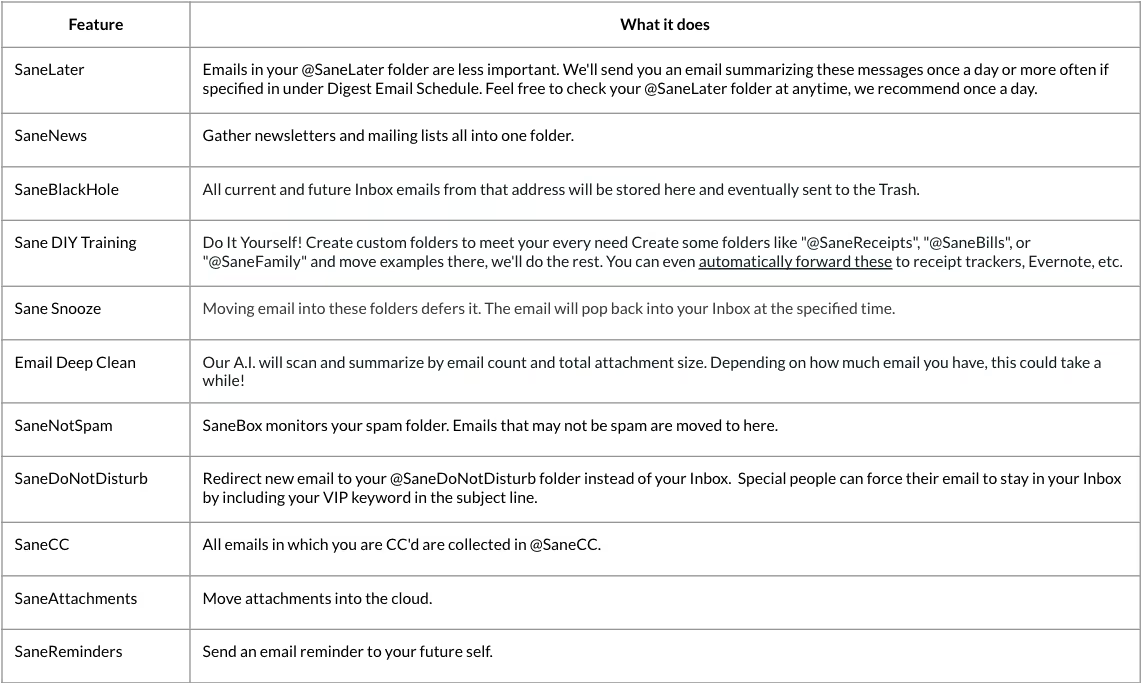
What Are the Pros and Cons of SaneBox?
To help you choose the best Sanebox alternative, we analyzed its strengths and weaknesses.
SaneBox Pros
- Easy setup and use. SaneBox requires minimal effort to configure. Users just grant access to their email, and the service immediately starts filtering incoming messages. There’s no complicated wizard or learning curve.
- Relatively low entry price. The basic “Snack” plan starts at just $7 per month per account. This affordable tier can accommodate individuals with modest filtering needs.
- Multiple account support. Higher tiers let you protect more mailboxes. For example, the mid-tier plan covers 2 accounts and the top-tier covers 4. This is useful if you have, say, one personal and one work address.
- Good for solo users. By design, SaneBox targets individual professionals. It works with any inbox and doesn’t impose a new UI, making it a lightweight solution for a single user. In fact, Gmelius’s blog notes SaneBox is “ideal for individual professionals overwhelmed by high volumes of email”.
- Dedicated support. Even on its lowest plans, SaneBox offers customer support (including live chat) to help users troubleshoot and learn the system. (All plans include support via the website or email.)

SaneBox Cons
- Limited features on basic plans. The entry-level “Snack” plan only lets you use two of SaneBox’s many features at a time, and the mid-tier plan unlocks only about six tools. Many of SaneBox’s smart folders and add-ons (attachments move, spam rescue, etc.) require the top “Dinner” plan. In other words, cheaper plans offer a very pared-down experience.
- Minimal AI beyond filtering. SaneBox markets itself as AI-powered, but its intelligence is largely restricted to sorting mail. It does not offer any modern AI assistants (for drafting replies or summarizing threads, for example). In practice it behaves more like a smart filter than a true AI assistant.
- No native team/collaboration tools. SaneBox operates at the individual inbox level. It does not include shared inboxes, team notes, or project boards. If multiple people need to work together on email, SaneBox provides no built-in way to assign tasks or share context (unlike some of the alternatives below).
- Automation limited to email sorting. All SaneBox rules revolve around moving or summarizing mail. There are no advanced automation workflows, integrations with calendars/tasks, or custom scripting. For example, you cannot set up multi-step email sequences or triggers outside of SaneBox’s basic filters.
- No third-party integrations. SaneBox largely runs in isolation. It doesn’t hook into apps like Slack, Trello, or Zoom. All actions happen via your email folders. Users who need a more connected workspace won’t find it here.
- Cost accumulates. Because SaneBox charges per feature (2 features/6 features/all features), the subscription cost increases substantially if you want to unlock the full platform and get beyond the paywall. This brings us to the next key consideration when analyzing SaneBox alternatives: pricing.
SaneBox Pricing Analyzed: Is It Worth It?
SaneBox offers three main plans (often called Snack, Lunch, and Dinner) with increasingly more features and account limits. The breakdown is roughly as follows:
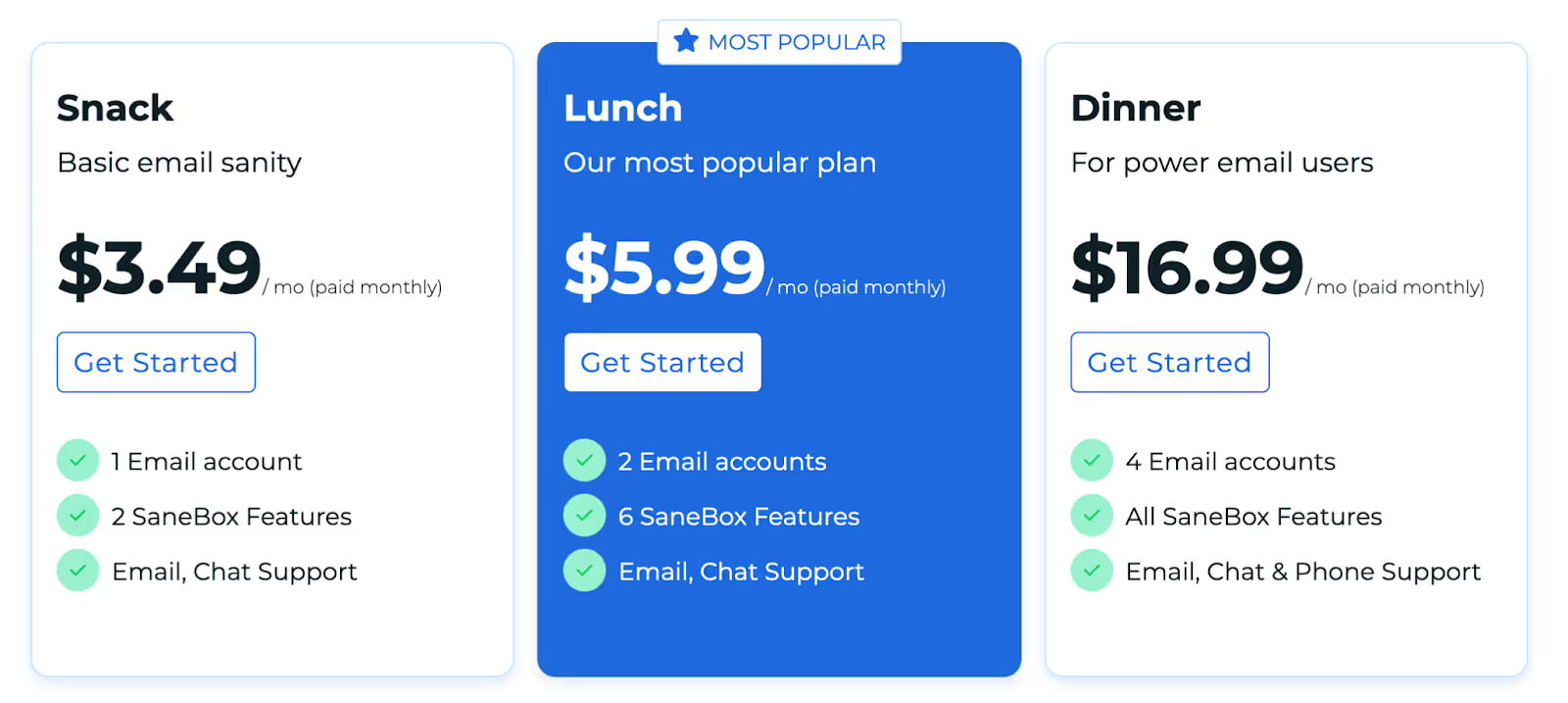
- Snack Plan: $3.49/month (or $48.96 for 2 years) for 1 email account, access to any two SaneBox features (for example, SaneLater + Snooze).
- Lunch Plan: $5.99/month (or $84 for 2 years) for 2 email accounts, access to six features.
- Dinner Plan: $16.99/month (or $239.04 for 2 years) for 4 email accounts and all features.
All plans come with a 14-day free trial and can be billed monthly, annually, or biannually.
Evaluating this pricing: the bottom line is that you get a narrow set of tools for each price tier. At $3.49/month you can’t do much beyond defer two types of mail. For $5.99 you unlock more utilities but still cap out at 2 inboxes.
Only the $16.99 plan allows full customization and multiple accounts. At that cost, you might as well pay slightly more each month for a wider set of features, like AI drafting or email-based project management.
For example, Gmelius charges $24–$36 per user per month (billed annually) but includes collaborative shared inboxes, templates, automation rules, and AI tools at that price. SaneBox, by contrast, essentially offers only filtration for the entry-level plan.
Unless you have a very simple use case (one user, one inbox, basic filtering), SaneBox’s plans feel expensive for what they deliver.
Also, be warned that Sanebox follows localized pricing. While it may be relatively affordable in some regions, entry-level monthly prices can be as high as $7, going up to $36 if you want to access all its features.
Our analysis shows that SaneBox’s pricing isn’t a bad value if its specific filters and email folders are all you need. But for growing teams or feature-hungry users, the cost quickly outweighs the benefits.
What Are the Top SaneBox Alternatives?
Several email productivity platforms compete in this space. Below we analyze the top five tools, highlighting what each does better than SaneBox. Each SaneBox alternative is focused on solving email overload, but with different emphases:
1. Gmelius
Gmelius is a collaboration and automation suite built for Gmail and Google Workspace teams. Unlike SaneBox’s “passive” approach, Gmelius turns your inbox into a shared workspace.
Key advantages over SaneBox include shared team inboxes, Kanban-style project boards inside Gmail, and real-time chat-style conversation threads.
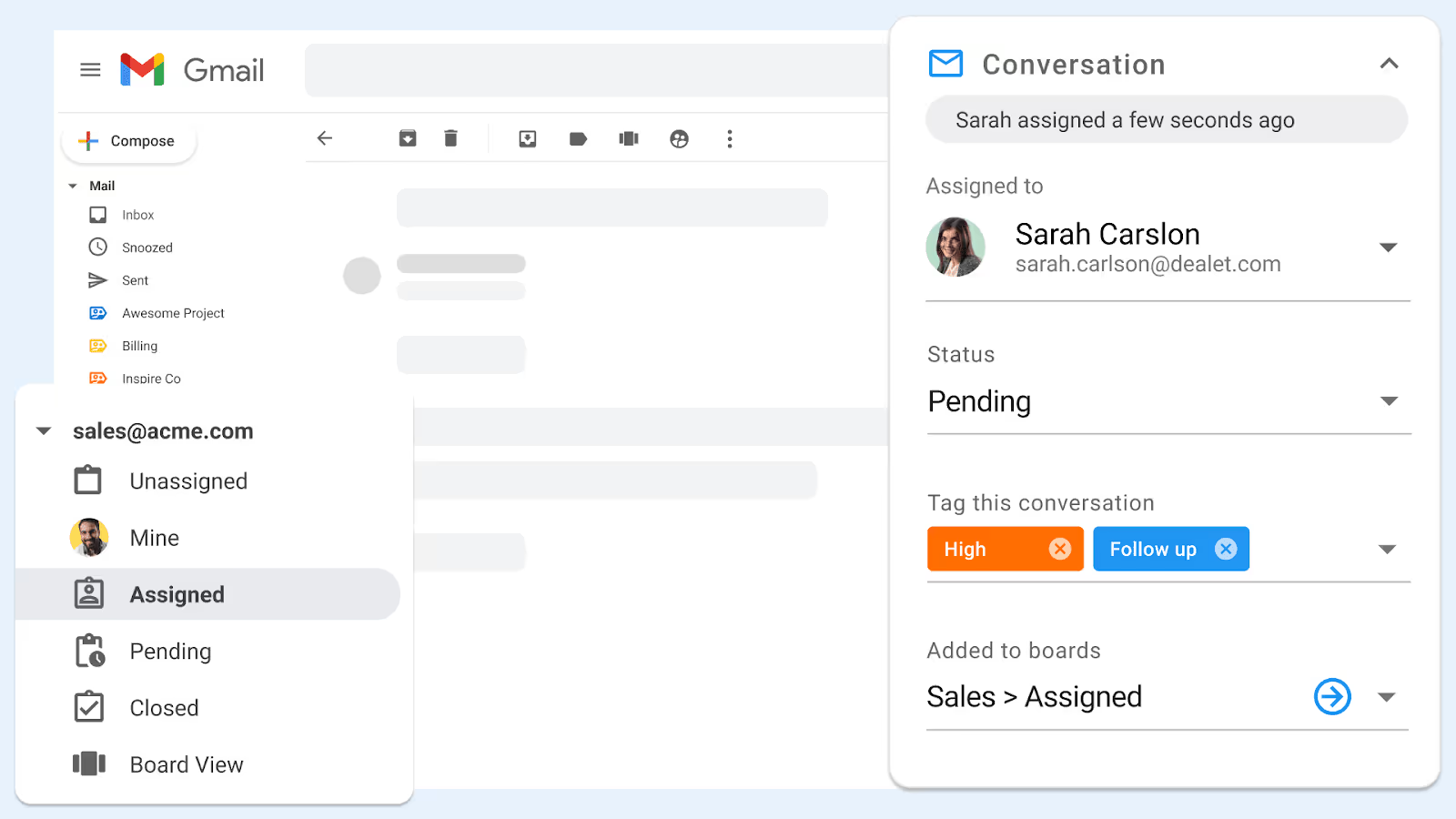
For example, Gmelius lets teammates co-manage a support@ or sales@ mailbox: they can assign emails to each other, leave internal notes, and follow the conversation as a visual pipeline. It also integrates with tools like Slack and Trello, unifying workflows across apps. In short, Gmelius centers on team features – something SaneBox has no answer to.
At the same time, Gmelius offers individual productivity features too, including AI email assistants for drafting replies and sorting mail. (Its AI “Reply Assistant” can auto-generate responses, and its sorting AI triages incoming email – capabilities beyond SaneBox’s basic filtering.)
Pricing-wise, Gmelius is tiered per user: the Growth plan is $24/user/month (annual) and Pro is $36. For that price you get the full collaboration suite.
2. Superhuman
Superhuman is a Gmail and Outlook client that prioritizes speed and a clean interface. Its advantages as a SaneBox alternative include blazing keyboard shortcuts, instant search, read-receipts, and snappy composition.
It also has built-in AI features: for example, an “Ask AI” tool that can auto-draft or suggest improvements to your replies. In practice, many users say they process email much faster with Superhuman’s slick UI.
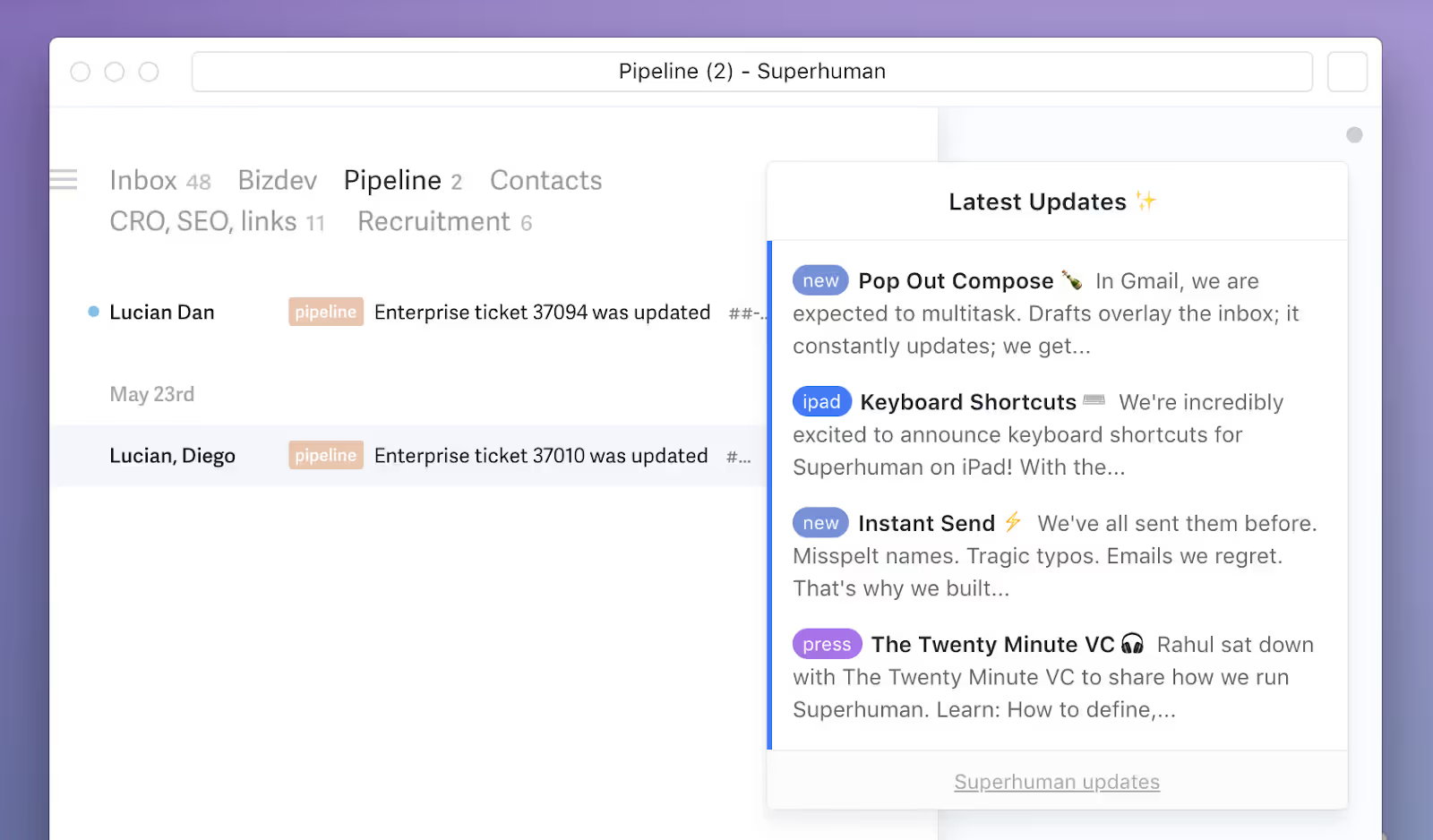
Superhuman is better than SaneBox in raw speed and user experience. Its instant keyboard-driven workflow is something SaneBox lacks entirely. However, it still operates one inbox per person (no shared inbox or team boards), so it’s mostly a single-user upgrade.
3. Fyxer
Fyxer is an AI-powered email assistant that automatically cleans and drafts your email. It shares SaneBox’s mission of organizing inbox chaos, but leans heavily on generative AI. Every incoming email is tagged and categorized, and Fyxer proactively writes draft replies in your style. It also acts as a meeting note-taker and scheduler, which SaneBox does not.
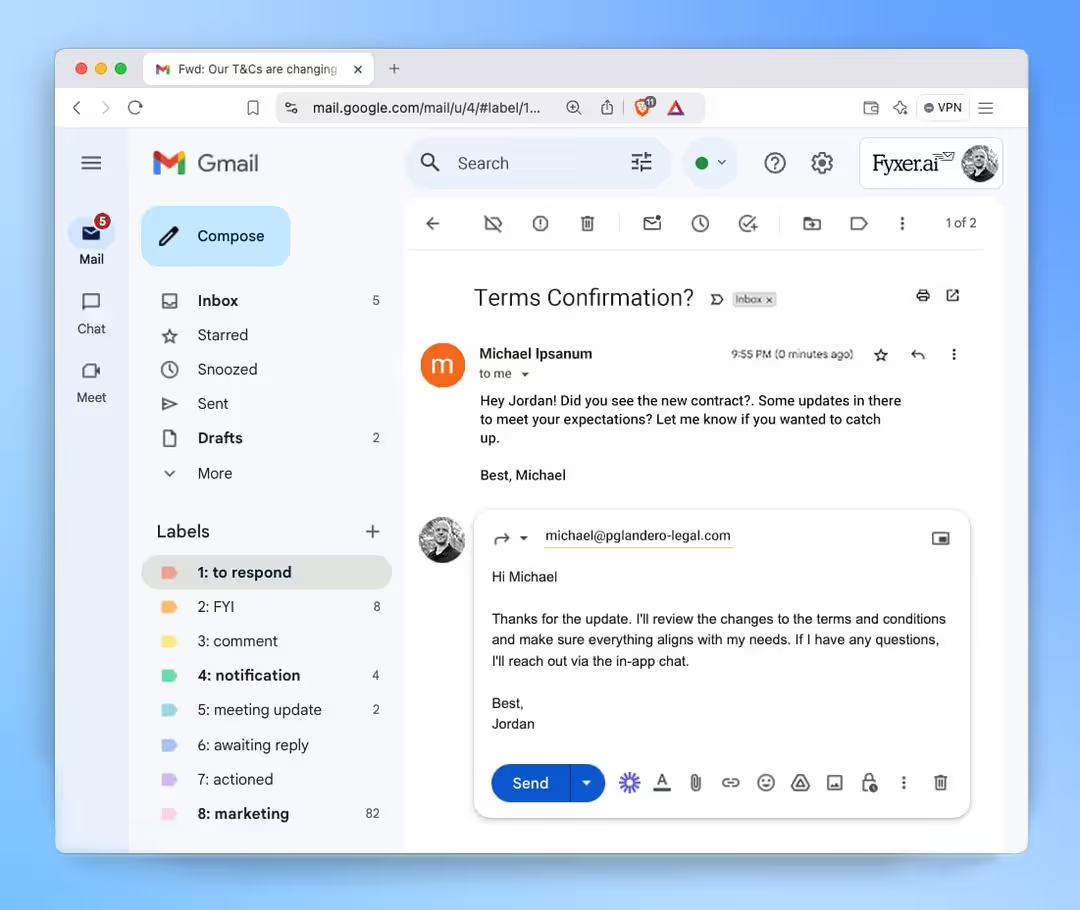
Its advantage as a SaneBox alternative is clear: Fyxer uses modern AI to do the work for you, not just filter it. Instead of burying a message in a folder, Fyxer might draft the reply immediately. It even reads attachments and integrates with CRM systems on higher plans.
However, like Superhuman, Fyxer focuses on the individual user (or a very small team). Also, it does not reside in Gmail and you might find yourself constantly switching apps.
4. Missive
Missive is a team inbox platform that combines email, chat, and tasks in one app. Its standout feature is real-time collaboration. For instance, teams can share multiple inboxes (support@, info@, etc.) and work on conversations together.
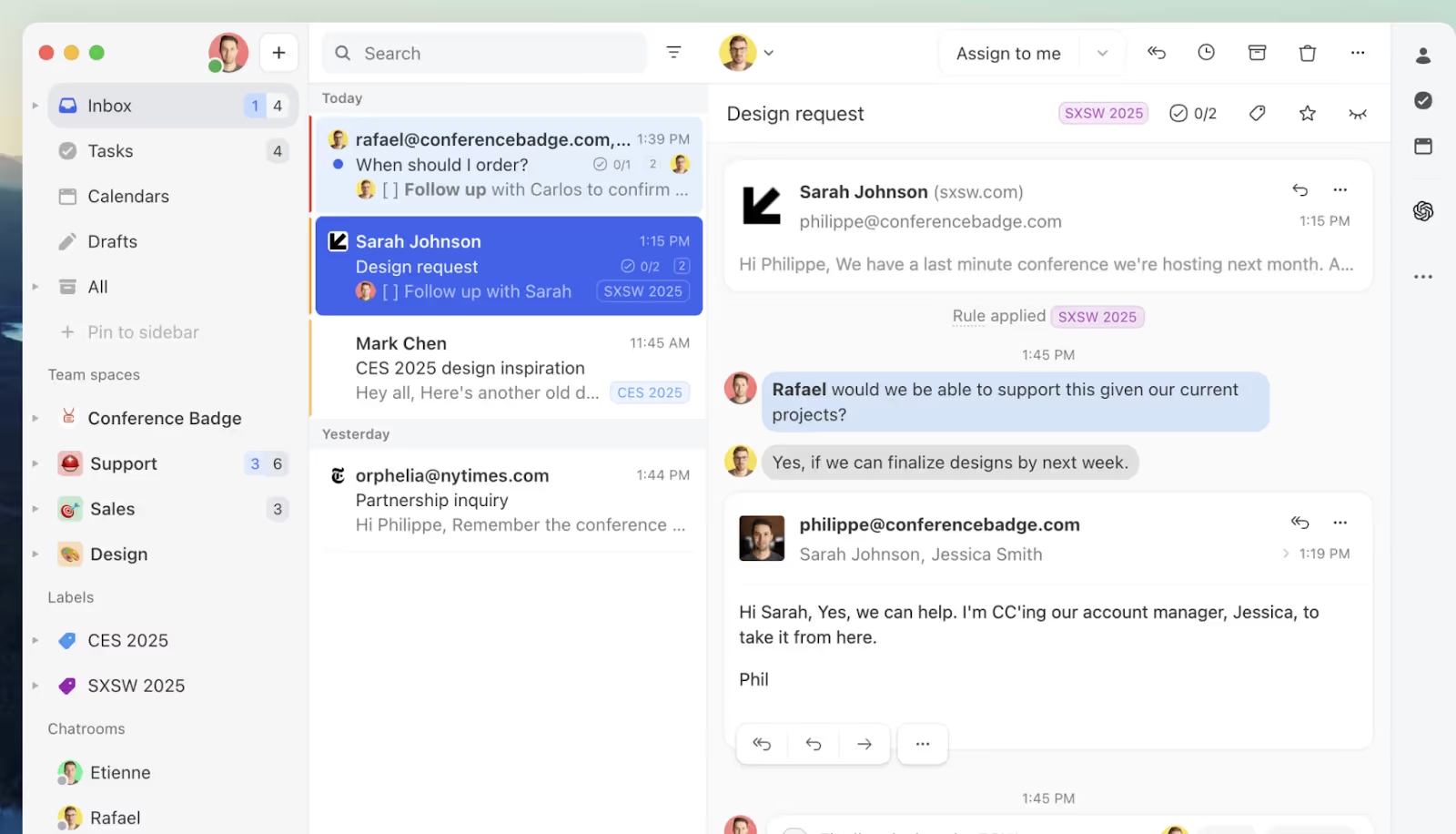
Missive includes internal chat threads, shared drafts, and assignable conversations. Everyone on the team can see who’s working on an email, and you can even tag teammates inside an email thread. It’s basically email + Slack in one.
This collaborative design is a huge plus over SaneBox, which has none of these features. However, it lacks a few advanced functionalities like integrated project boards.
5. Hiver
Hiver is another Gmail-centric tool built for customer-support teams. Its core strength is turning Gmail into a helpdesk: you get shared mailboxes, email assignment, SLA tracking, and collision detection. Every incoming email can be tagged or assigned to a teammate in a couple of clicks. There are features like shared email templates and analytics on response time.

Over SaneBox, Hiver’s advantage is obvious: it adds direct team collaboration and workflow features to email. One of its shortcomings, however, is multi-channel workflow rules and integrations, as well as the automation aspect.
Both Hiver and Missive beat SaneBox on support use cases, but we give the edge to Gmelius for having those features and more.
P.S. If you’re considering Hiver as a SaneBox alternative, check out our Gmelius vs. Hivers comparison for a deeper analysis.
Why is Gmelius a Top Sanebox Competitor?
Not to toot our own horn, but Gmelius stands out because it was built around Google Workspace and team collaboration, whereas SaneBox was built for personal email. Here’s why Gmelius is often considered the premier alternative:
1. Designed for Google Workspace
Gmelius is a Gmail/Workspace extension from the ground up. It embeds directly into Gmail and Google Calendar. (There’s also an Outlook version, but its strength is the deep Gmail integration.) By contrast, SaneBox works with any mail service, but Gmelius only works on top of Google Workspace. This focus allows Gmelius to leverage Gmail’s interface and add powerful overlays..
2. Powerful team features
Gmelius offers shared inboxes, shared labels, and internal chat threads so that teams can co-manage email. You get assignable conversations (like service tickets), email sequences (automated follow-ups/drip campaigns), and visual project boards linked to emails.
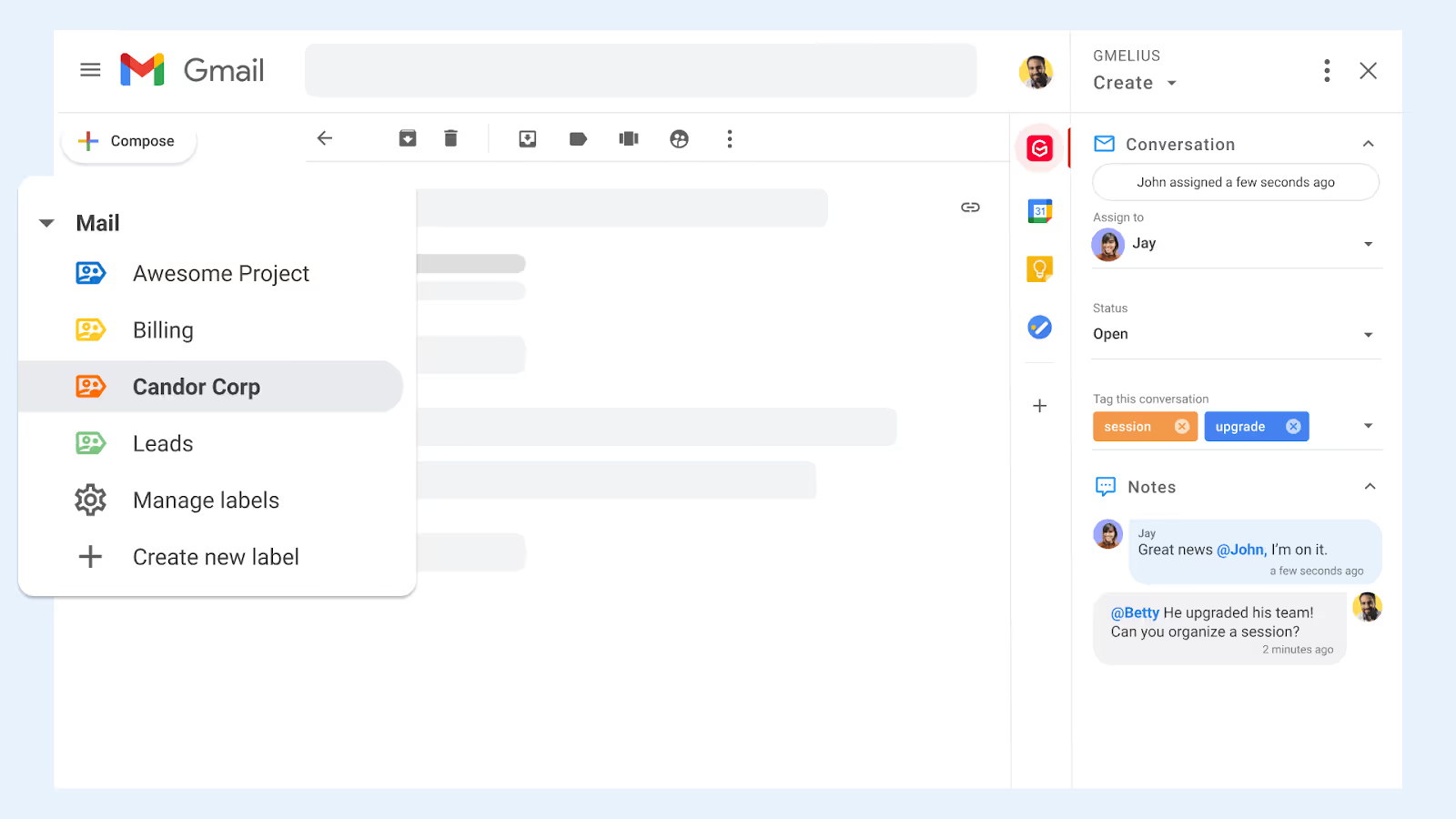
Gmelius lets you treat emails as tasks in a shared Kanban or pipeline. For example, you could add a label to move a thread into a “Deal Pipeline” board within Gmail. These capabilities simply don’t exist in SaneBox.
3. Low-code automation across apps
Gmelius includes an automation engine that is as easy to configure as “if-this-then-that” rules. You can auto-assign emails based on content or funnel messages into different channels. For instance, you might automatically forward new leads to a CRM, or tag notifications from Slack back into Gmail.
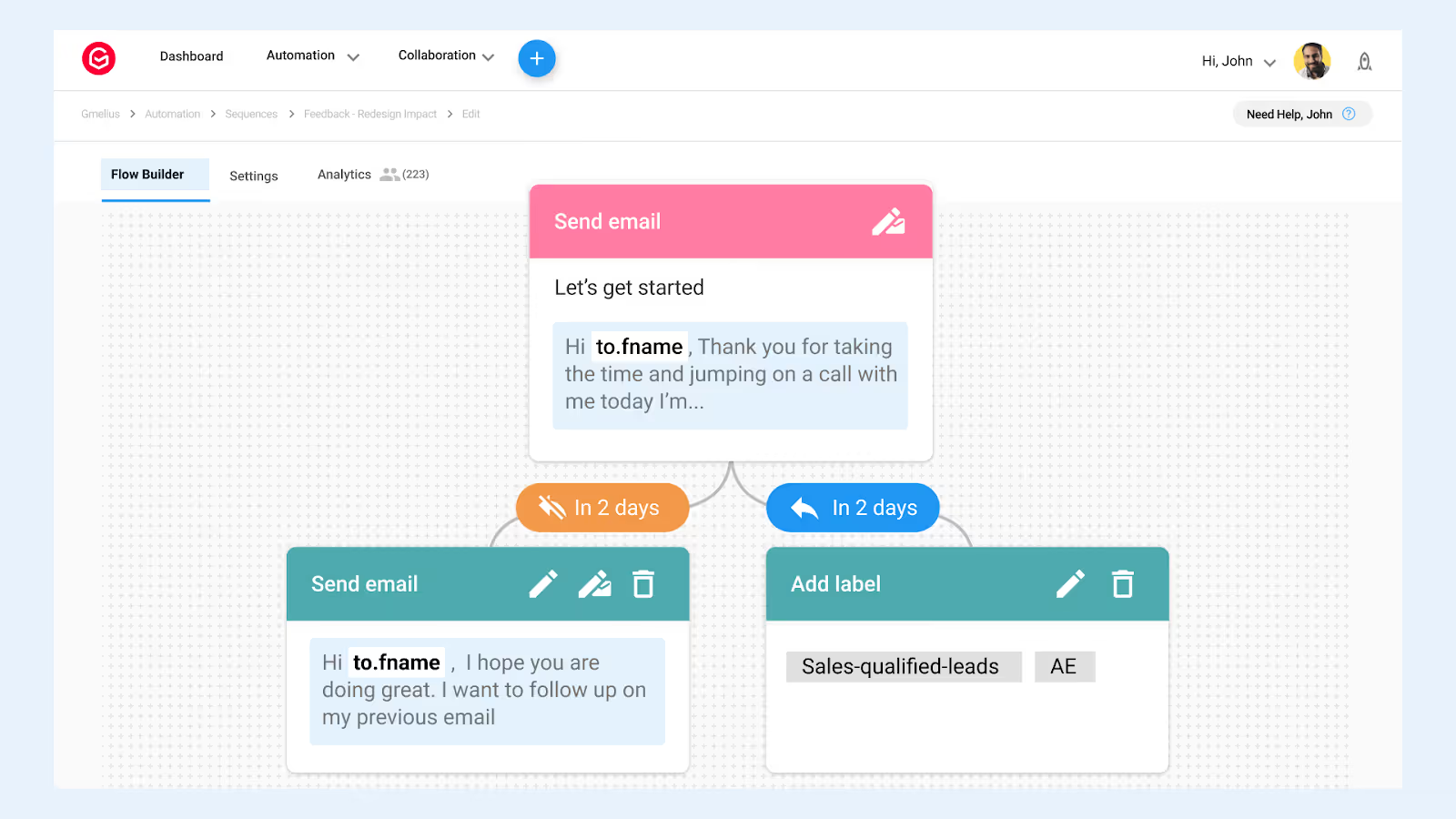
These connected workflows extend beyond email. Gmelius even syncs with Slack and Trello, so your teams stay coordinated in whatever tool they prefer. In short, Gmelius is not just email sorting; it’s email-driven process automation.
SaneBox has no equivalent – it only moves mail to folders, whereas Gmelius can trigger multi-step sequences.
4. AI assistants for email
Recently, Gmelius introduced AI-powered helpers directly in your inbox. These agents will draft replies for you and sort your incoming mail using AI models. For example, its “Reply Assistant” will generate a suggested email response which you can edit, much like Superhuman’s AI tools. It also has an AI sorting assistant that predicts where an email should go.
This goes well beyond SaneBox’s simplistic filtering; here Gmelius uses AI to augment your writing and workflow.
Plus, these AI tools work in tandem with the shared inbox features – so it can even draft replies on behalf of a team member, if assigned.
5. Better value for your investment
Finally, Gmelius offers these rich features at a competitive price. Its Growth plan (including shared inboxes and basic automation) is $24/user/month (annual billing). Given that this includes team collaboration, templates, sequences, team analytics and AI, most businesses find it a good deal.
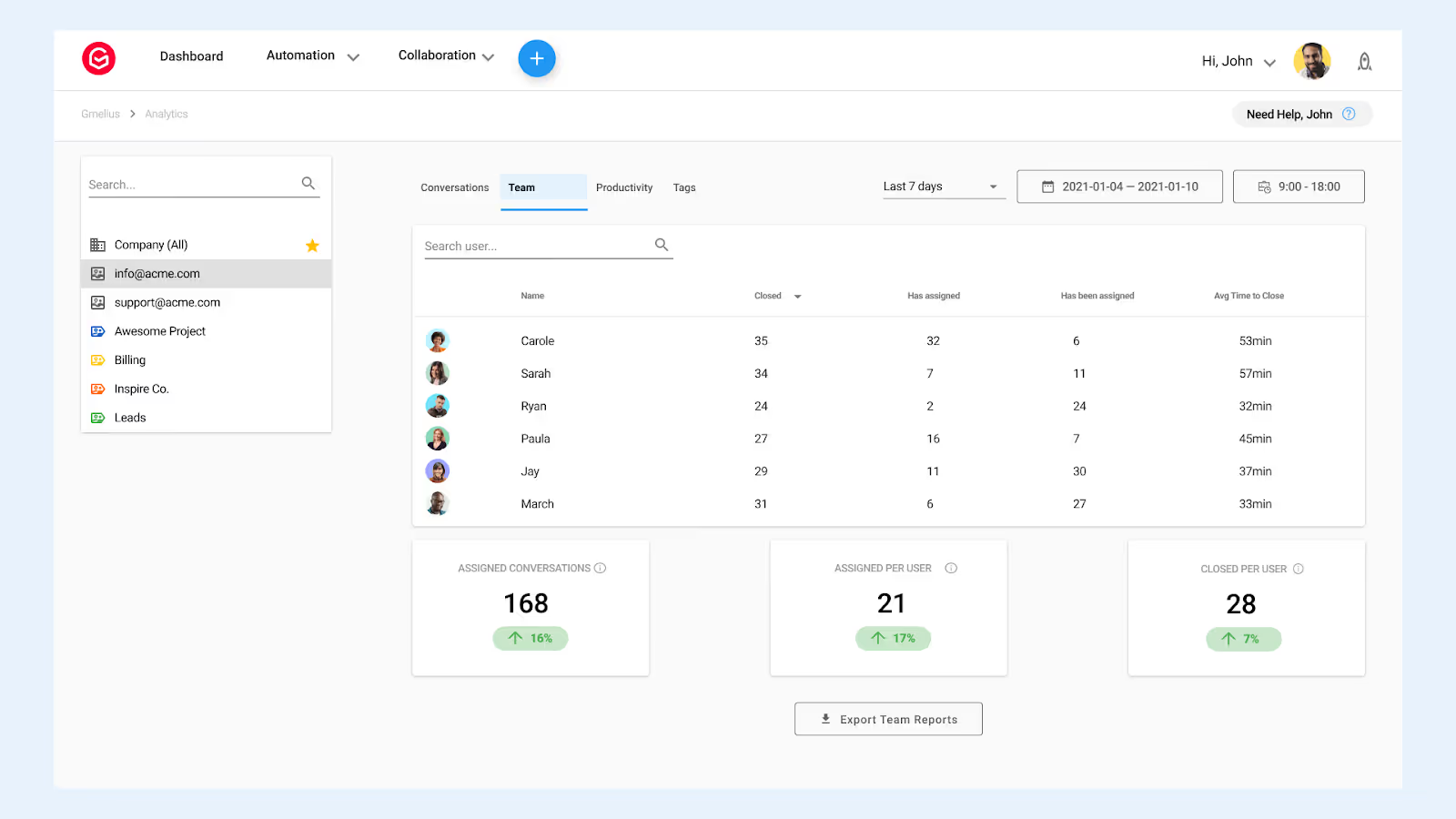
By comparison, SaneBox’s pricing tops out at $36/month for 4 inboxes but still offers only basic filters and reminders. In effect, you pay more for SaneBox yet get less functionality.
SaneBox vs. Gmelius Compared Side by Side
Here is a quick comparison with a top SaneBox alternative to help you choose the best email management solution for your team:
Verdict: What Is the Best SaneBox Alternative?
In the battle of email assistants, it ultimately comes down to your use case. If you are a solo user who just wants to filter newsletters and snooze messages, SaneBox will work, but don’t expect any more than that. For almost everyone else, especially teams, one of the competitors offers more bang for your buck.
Gmelius stands out as the best all-around alternative for most scenarios. It covers everything SaneBox does (smart filtering, snoozing, reminders) and much more. With Gmelius, your Gmail inbox becomes a collaborative workspace.
You get AI-powered reply drafting and smart sorting, plus the ability to share inboxes, assign tasks, and automate multi-step workflows.
Essentially, Gmelius can transform Gmail into a collaboration platform with shared, assignable inboxes powered by AI. The cost (around $24/user/mo) is higher than SaneBox’s starter plan, but considering the host of features included, it offers far better value.
Other SaneBox alternatives like Fyxer and Superhuman bring strong AI and speed to personal email, which some may prefer. Missive and Hiver bring excellent shared-inbox features for teams. However, each of those has its own niche. Gmelius hits the sweet spot by blending team collaboration, workflow automation, and AI productivity in a single package.
Summing Up
In conclusion, if SaneBox’s limited inbox filtering has left you yearning for more powerful tools, look first to Gmelius. It inherits the mail-sorting DNA of SaneBox but adds the team-friendly, AI-driven capabilities that SaneBox lacks.
For professionals handling large volumes or collaborative projects, a reliable SaneBox alternative definitely makes more sense, saving you the cost and hassle of switching later on, once the dependencies have kicked in.
